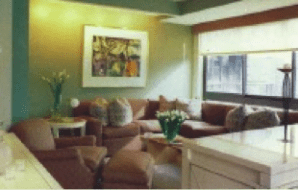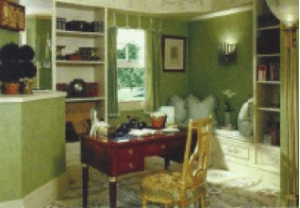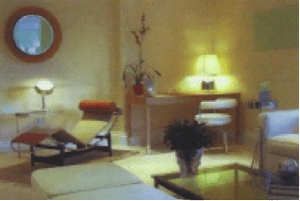The Study: To Read, Write and Relax
“Eye on Design” Archive from Mann Report (Article By Gail Green)

The Study, in past times a place for quiet reflection and thought, has become a more versatile, less constricted room for a variety of activities. Its umbrella of purpose can now includes its being a library, a media center, a private retreat, a computer center, a less formal family gathering place, a sitting room, a partial dining facility, a potential art gallery, a sanctuary for contemplation and medication and any combination thereof.
Traditionally, the study is thought of as a place to read and write, where one’s daily business of to-do lists and the payment of bills are executed. In this sense, its function still reigns. However, other practical and perhaps less pragmatic uses are simultaneously present. For instance, the study can become a library. It can have built-in book- cases, housing collections of rare tomes. As a research facility, one can research and write, compose and edit. There is always a desk and accommodating light.
As a media center, the study provides umbrage for the television, stereo and other audio equipment. In fact, in this instance, the surrounding furniture usually wraps around the room so that its primary focus is visual.
The study as a private retreat works especially well in its ability to provide refuge and relaxation for the inhabitant. Oftentimes, it is very cozy, sometimes small, and usually warm in ambience. It can be sparse or very filled with objects depending on one’s aesthetic preference, but it always houses one’s favorite things, those memorabilia close to the heart. Usually, there is a window seat, connecting outside observation to quiet reflection and thought. And, often, it is a private place for one.
As a computer center, the study becomes more modernistic and functional. Equipment is placed on appropriate desks accompanied by possible side tables for ancillary paperwork. File cabinets, boxes, piles of papers, newspapers, etc. are all found here.
Perhaps the study’s most modern and functional responsibility is that of a less formal family gathering place where a multitude of activities are possible. Usually, the decoration is very casual, simpler in taste. Fabrics are less formal. Here, shoes are discarded in favor of putting one’s feet up to relax and chat. Conversation flows more easily in this more relaxed atmosphere. Furniture arrangements are more casual, too. Usually side tables for snacking are present and usually the television is of importance.
As a sitting room, the study becomes more formal. A chaise lounge, a settee, a window seat are all probable elements to this space. Antiques are usually the flavor with beautiful objet d’art reigning. There can also be a small desk and elegant chair, genteel fabrics, fanciful window treatments and an acute attention to derail. The study can sometimes second as a dining area. In this respect, its function is separate yet maintains a contiguous relationship to a less formal space like a family room. It works well because the whole family can share simultaneously in different experiences.
As an art gallery, the study’s walls can reflect more personal choices in art. The major rooms seem to reflect serious collections, but here more whimsical selections are possible. The Study as a sanctuary for contemplation and thought, though Eastern in feeling, can be as small as a closet or as large as a separate edifice. It often encompasses greenery as in a conservatory or an oriental chapel of sorts, land-scaped with water and rocks.
As any one or a combination of the above functions, the Study serves a multitude of purposes. It reflects the personal lifestyle and character of its owner.



*Note – Article adapted from print. Images reflect reduced quality.
Click here to view original print article.
____
Like this post?
Subscribe to our newsletter for more design tips, tricks and insights!

